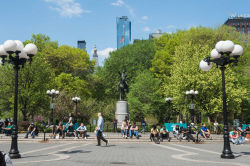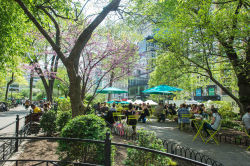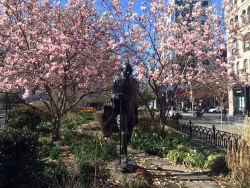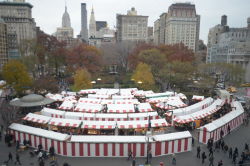Union Square Park
View all monuments in NYC Parks, as well as temporary public art installations on our NYC Public Art Map and Guide.
George Washington
| Artist: | Henry Kirke Brown J.Q.A. Ward. assistant |
| Dedicated: | July 4, 1856 |
| Location: | South end |
Artwork History
This impressive bronze equestrian portrait of George Washington (1732-1799), the first president of the United States, is the oldest sculpture in the New York City Parks collection. It was modeled by Henry Kirke Brown (1814-1886) and dedicated in 1856.
George Washington was born into a prosperous family on February 22, 1732, in Westmoreland County, Virginia. He was privately educated and gained experience as a land surveyor, before joining the militia. He served as an officer in the French and Indian Wars from 1755-1758. After rising to the rank of colonel, he resigned his post and married Martha Dandridge (1731-1802), returning as a gentleman farmer to the family plantation at Mount Vernon, Virginia.
He soon reentered public life, and served in succession as a member of the Virginia House of Burgesses (1759-74), and as a member of the First and Second Continental Congresses (1774-75). Upon the outbreak of the American Revolution in 1775, Washington was made Commander-in-Chief of the Continental Army. His military prowess and inspirational leadership held the colonial armies together against overwhelming odds, and secured the evacuation and defeat of the British in 1783.
Washington again retired to Mount Vernon, but his dissatisfaction with the new provisional government caused him to resume an active role, and in 1787, he presided over the second federal constitutional convention in Philadelphia. He was then unanimously chosen first president of the United States, and was inaugurated at Federal Hall in New York City on April 30, 1789. Washington was reelected to a second term in 1793, declined a third term, and retired from political life in 1797. Often referred to as "the father of our country," Washington is universally regarded as having been instrumental in winning the American Revolution and in establishing the new nation.
In 1851, a committee of concerned citizens interested in erecting a monument to Washington in New York approached sculptor Horatio Greenough (1805- 1852), known for his huge classical marble portrait of Washington. Simultaneously, the committee also invited Henry Kirke Brown to submit a design, though it was unclear whether he was to assist Greenough or compete with him for artistic selection. Any prospect of collaboration evaporated with Greenough's premature death in December 1852.
Though Brown, like many of his generation, made an obligatory visit to Italy to study, he was part of a group of sculptors attempting to establish a truly American sculptural idiom. His first major public commission was a statue of De Witt Clinton (1769-1828) which he completed for Greenwood Cemetery in 1852. Working at a specially equipped studio in Brooklyn, and assisted extensively by John Quincy Adams Ward (1830-1910), who himself would attain renown as a sculptor, Brown spent 18 months modeling the horse and rider.
The moment Brown depicts is that of Evacuation Day, November 25, 1783, when Washington reclaimed the city from the British. With outstretched hand, he signals to the troops in a gesture of benediction, a sculptural motif indebted to precedents from antiquity, most notably the Marcus Aurelius statue on Rome's Capitaline Hill. Yet Brown's attention to detail, and the life with which he infuses his subject, unites classical gestures and pose with what has been described as a "simple and direct naturalism." The piece was cast at the Ames foundry in Chicopee, Massachusetts, one of the first foundries in the United States capable of such large- scale quality work. The names of the donors are inscribed on the skyward face of the bronze sub-base. Brown also sculpted the statue of Abraham Lincoln on the north side of park.
On June 5, 1856, the Washington statue was installed on a simple granite base designed by Richard Upjohn. The event drew thousands of spectators. One month later, on July 4, the statue was formally conveyed to the custody of the City of New York. At that time the sculpture stood in a fenced enclosure in the middle of the street, at the southeast corner of the square. As part of the redesign and reconstruction of the park in 1929-30, the sculpture was moved from this traffic island (where it was prone to vehicular traffic and pollution) to its present location and placed centrally in the south plaza. Here it has stood in alignment with Henry Kirke Brown's sculpture of Lincoln-relocated at that time to the northern park path.
In 1989, the sculpture was conserved, and the missing sword and bridle strap recreated through the Adopt A-Monument Program, a joint venture of Parks, the Municipal Art Society, and the New York City Art Commission. The Citywide Monuments Conservation Program, a public-private initiative, conserved the sculpture in 2001, and performed additional restoration of the bronze in 2004 and granite pedestal in 2006.
In the aftermath of the attacks on the World Trade Center on September 11, 2001, the George Washington sculpture served as a touchstone for collective grieving and public expression, and became the central focus of a massive around-the-clock community vigil and a provisional shrine. These events reaffirmed the symbolic power of New York City's most venerable outdoor work of art.
Artwork Details
| Description: | Equestrian figure on intergral plinth, pedestal on plinth |
| Architect: | Richard Upjohn |
| Materials: | Bronze, Barre granite |
| Dimensions: | Overall H: 26'4"; Statue H: 13'6"; Pedestal H: 12'2" W: 7'9" L: 15'; Pedestal plinth H: 10" W: 9'9" L: 17' |
| Foundry: | Ames Foundry, Chicopee, Mass. |
| Donor: | Merchants of New York |
| Cast: | 1856 |
Please note, the NAME field includes a primary designation as well as alternate namingsoften in common or popular usage. The DEDICATED field refers to the most recent dedication, most often, butnot necessarily the original dedication date. If the monument did not have a formal dedication, the yearlisted reflects the date of installation.
For more information, please contact Art & Antiquities at (212) 360-8163.
Check out your park's Vital Signs
Clean & Safe
Green & Resilient
Empowered & Engaged Users
Share your feedback or learn more about how this park is part of a
Vital Park System





